Welcome to our blog on tulsi farming! Tulsi, also called holy basil, is a highly revered plant in Indian culture and is used in religious and medicinal practices. Not only is it considered sacred, but it also has a wide range of health benefits. In this blog, we will not only discuss the cultural and health significance of Tulsi, but we will also share with you how you can earn a significant income by farming tulsi.
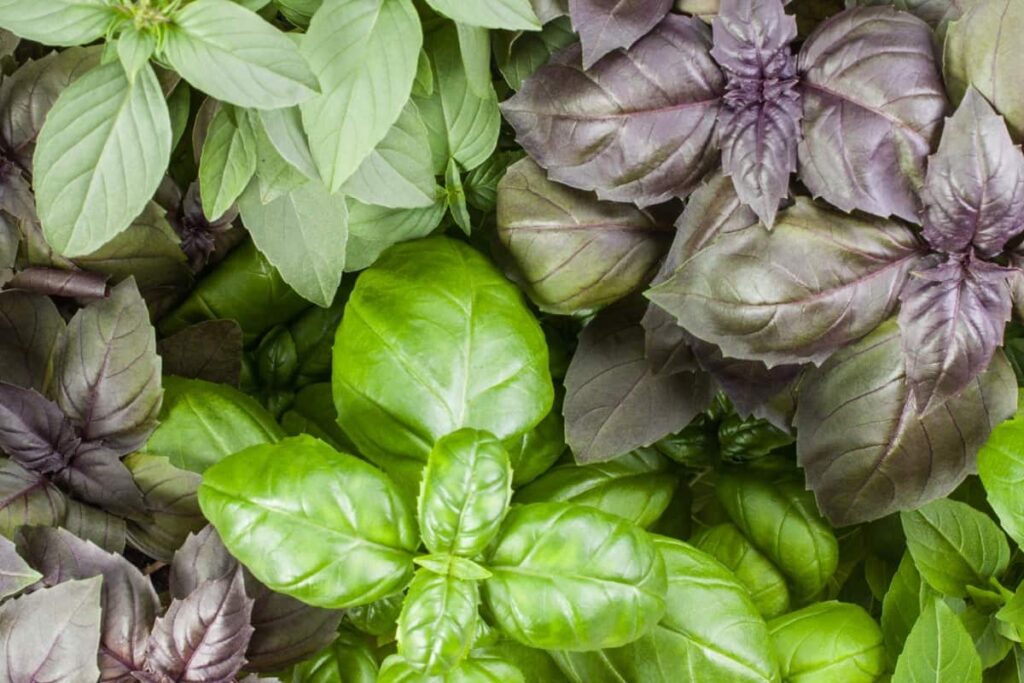
With the proper knowledge and techniques, it is possible to earn up to 2 lakh rupees per month from tulsi farming. Whether you are a farmer looking to diversify your crop or a homesteader looking to start a new venture, this guide is for you. We will cover everything from tulsi farming to advanced techniques for maximizing yield and profits. So, let’s start your journey to becoming a successful tulsi farmer.
How to earn 1 lakh per month from Tulsi
What is Tulsi farming
Tulsi farming is the cultivation of the tulsi plant, also known as holy basil or Ocimum tenuiflorum. The plant is a perennial and is considered sacred in Indian culture. It is used in religious practices and has many health benefits. The Tulsi plant is typically grown for its leaves, which are used for medicinal purposes, and for its seeds, which are used for oil production.
The Tulsi plant can be grown in various conditions, including greenhouses, open fields, and even pots. The plant requires well-drained soil, ample sunlight, and regular watering. Proper care, such as pruning and fertilization, is also necessary to ensure a healthy and productive crop. With the proper knowledge and techniques, tulsi farming can be profitable and sustainable.
Benefits of Tulsi plant, leaves, and oil
Tulsi, also known as holy basil, is considered a sacred plant in Indian culture and is used in religious and medicinal practices. It has a wide range of health benefits, including:
- Stress relief: Tulsi is believed to have adaptogenic properties, which help the body cope with stress. It is also used as a natural remedy for anxiety and depression.
- Respiratory health: Tulsi is beneficial for respiratory health, and it is traditionally used to treat asthma, bronchitis, and other respiratory conditions.
- Anti-inflammatory properties: The compounds present in Tulsi used for anti-inflammatory properties can help reduce inflammation and alleviate symptoms of arthritis and asthma.
- Cardiovascular health: Studies have shown that Tulsi can help lower blood pressure and cholesterol levels and prevent heart disease.
- Antioxidant properties: Tulsi is rich in antioxidants which help to protect the body from damage from free radicals and may reduce the risk of chronic diseases.
- Anti-cancer properties: Some studies have found that Tulsi may have anti-cancer properties and help prevent or slow cancer cell growth.
- Anti-bacterial and anti-viral properties: Tulsi has been found to have anti-bacterial and anti-viral properties, which can help to fight off infections and boost immunity.
- Helps in Digestion: Consuming tulsi leaves can help ease digestion and relieve constipation.
- Good for skin and hair: Tulsi is also suitable for skin and hair. It can help to reduce acne and other skin problems. Additionally, it is believed to promote hair growth and prevent hair loss.
In case you missed it: Medicinal Plants Herbs Contract Farming in India: Profits, Companies for Tulsi, Ashwagandha, Brahmi, Aloe Vera, Shatavari, and More
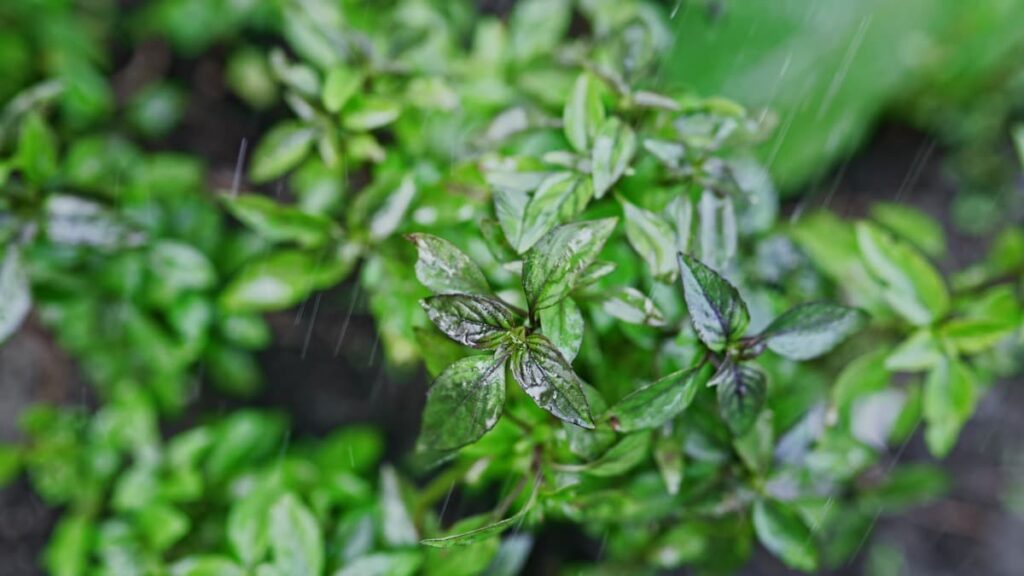
Different varieties of Tulsi plants
- Rama Tulsi: This variety has light green leaves and a milder flavor than the other types. It is considered to be the most beneficial for respiratory health. It is often used to make tea or added to soups and curries.
- Krishna Tulsi: This variety has dark purple leaves and a stronger, more pungent flavor than Rama tulsi. It is considered to have stronger medicinal properties and is often used in Ayurvedic medicine.
- Vana Tulsi: This variety has green leaves and grows wild in many parts of India. It is considered to have the most potent medicinal properties and is often used in essential oil production.
- Drudriha Tulsi: It is also known as the “thick stem tulsi” and is considered one of the most potent varieties of Tulsi. It is known for its strong medicinal properties and is often used in Ayurvedic medicine.
- Babi Tulsi: This variety is known as “bamboo tulsi” and is known for its tall, bamboo-like stem. It is considered to have medicinal properties and is often used in Ayurvedic medicine.
- Tukashmiya Tulsi: This variety is known for its strong and spicy aroma and is considered to have strong medicinal properties. It is also known for its strong anti-inflammatory properties.
- Amrita Tulsi: This variety is considered a hybrid of Rama and Krishna Tulsi and is known for its high oil content.
Major Tulsi cultivation areas
Tulsi is widely cultivated in many parts of India and other countries in Southeast Asia, Africa, and South America. In India, tulsi farming is widely practiced in many regions, including the southern states, the Bengal and Bihar region, Punjab, Maharashtra, the Himalayas, and the plains of India. The plant is well suited to grow in tropical and subtropical regions, which makes it ideal for cultivation in a wide range of Indian climates.
Best cultivation tips for farmers to earn 1.5 lakhs from Tulsi Farming
Climate requirement for Tulsi farming
- Tulsi plants require a warm, subtropical climate.
- The temperature should be around 30 degrees Celsius for proper growth and 21 degrees Celsius during germination.
- Rainfall should be between 80-120 cm.
- Tulsi plants grow best under full sun conditions but can also be grown in shaded regions with less oil content in leaves.
Process of nursery raising in Tulsi farming
From seeds
- Set up a nursery bed in partial shade and indirect sunlight
- Apply well-rotten farm yard manure at 2kg per square meter
- Mix Tulsi seeds with sand at a ratio of 1:4 and sow 10-15cm below the soil surface
- Germination occurs 8-12 days after sowing and can be transplanted after six weeks
In case you missed it: Earning 31 Lakhs from 9 Acre Jamun Farm: The Success Story of a Fruit Farmer in India
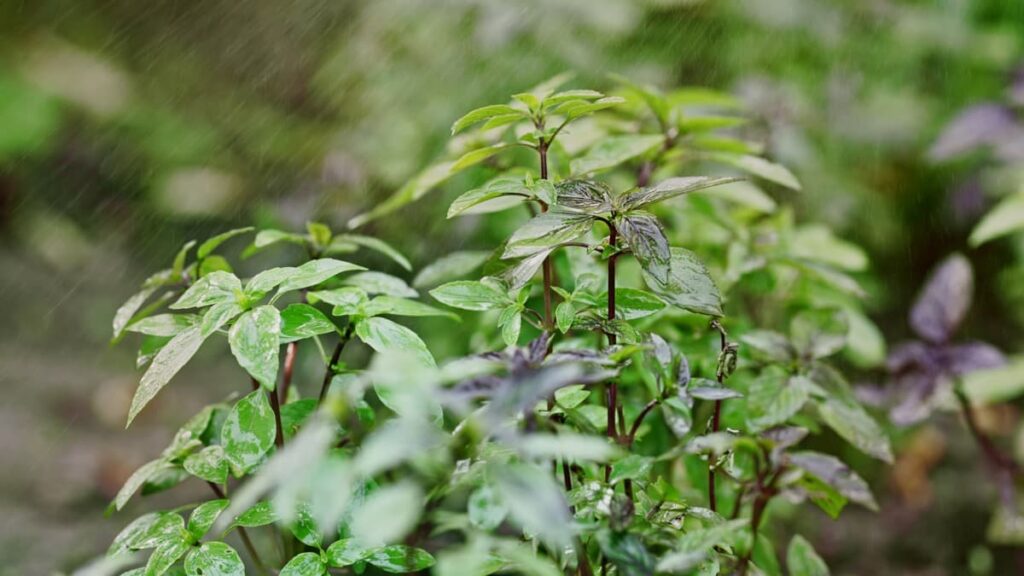
From cuttings
- Use cuttings with 8-10 nodes and a length of 10-15 centimeters
- Trim off all leaves except the first few pairs
- Plant in nursery beds or polyethylene bags and ready for transplanting after 4-6 weeks
Land preparation for Tulsi farming
- A second important step after preparing the nursery
- Includes three steps: preparing the land for transplantation.
- Soil selection: Sandy loam soils are preferred, with a pH range of 4.3 to 8.2, containing enough organic matter and proper drainage. Avoid waterlogged, saline, and highly alkaline soil types.
- Plowing of land: The land should be plowed 2 to 3 times to bring it to a fine tilth.
- Adding of manures: Mix Farm Yield Manure or inorganic fertilizers, such as 120:60:60 kg/ha of NPK, into the soil after plowing.
Transplanting of Tulsi plants
- Transplanting: Plants should be transplanted in lines, with a distance of 12 to 15 inches between plants and 18 to 20 inches between lines.
- Watering: Seedling beds should be watered 24 hours before transplanting.
Irrigation requirement
- Initial: Irrigation should be done during transplantation and twice a week for the first month.
- Ongoing: Irrigation should be done once a week from the second month or as needed based on the soil’s moisture level.
Prevention of weeds in Tulsi plantation
- High Planting Density
- Mulching
- Shallow Cultivation
- Less row Spacing
- Protection of the plants
In case you missed it: Growing Jowar (Sorghum) Organically in Maharashtra: Step-By-Step Cultivation Process and Production
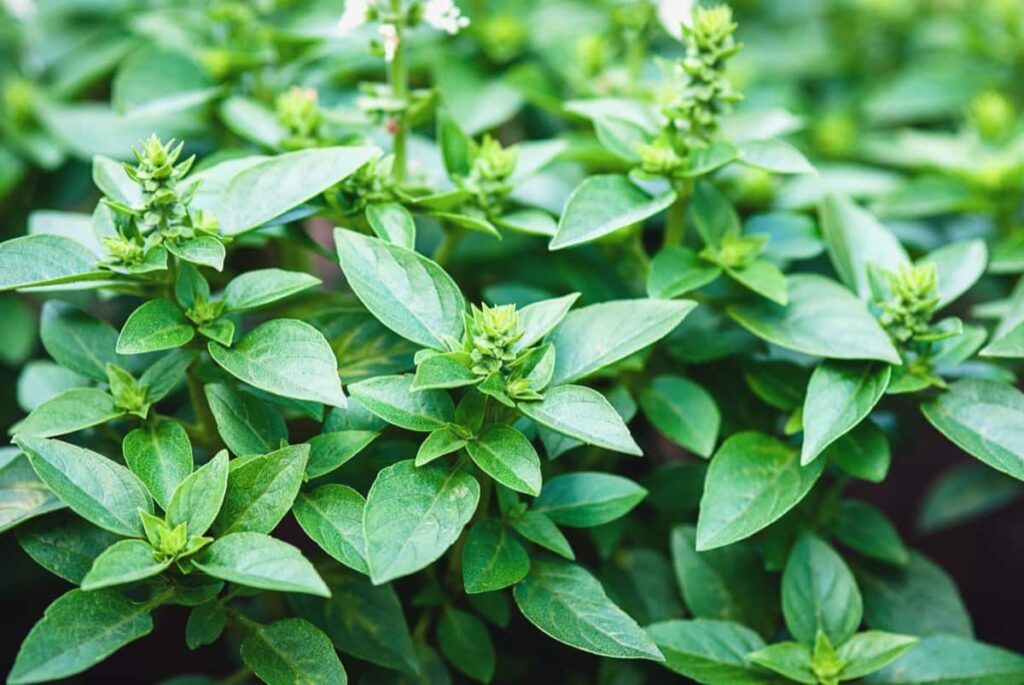
Pests and diseases in Tulsi farming
- Leaf Rollers
- Lace Wing
- Root rot
- Seedling blight
- Powdery mildew
Pesticides to use in Tulsi farming
- Malathion
- Methyl parathion
- Quinalphos
- Azadirachtin
- Wettable sulfur
Organic methods to control pests and diseases in Tulsi plant
- Fish oil resin soap
- Garlic, Vitex negundo, Lantana camera, Calotropis gigantean extracts
- Wettable Sulphur
- Mercurial Fungicide
Harvesting process in Tulsi farming
- First harvest after 90 days or three months of transplanting
- Harvesting is done during the full bloom period on bright sunny days
- Harvest by cutting the plant at least 15cm above the ground level
- Subsequent harvests every 70-75 days
- The yield of 5-6 quintals of dry leaves per acre
In case you missed it: Chicken Farming in Indonesia: Poultry Business Plan, Setup Cost, License, Profit, and Requirements
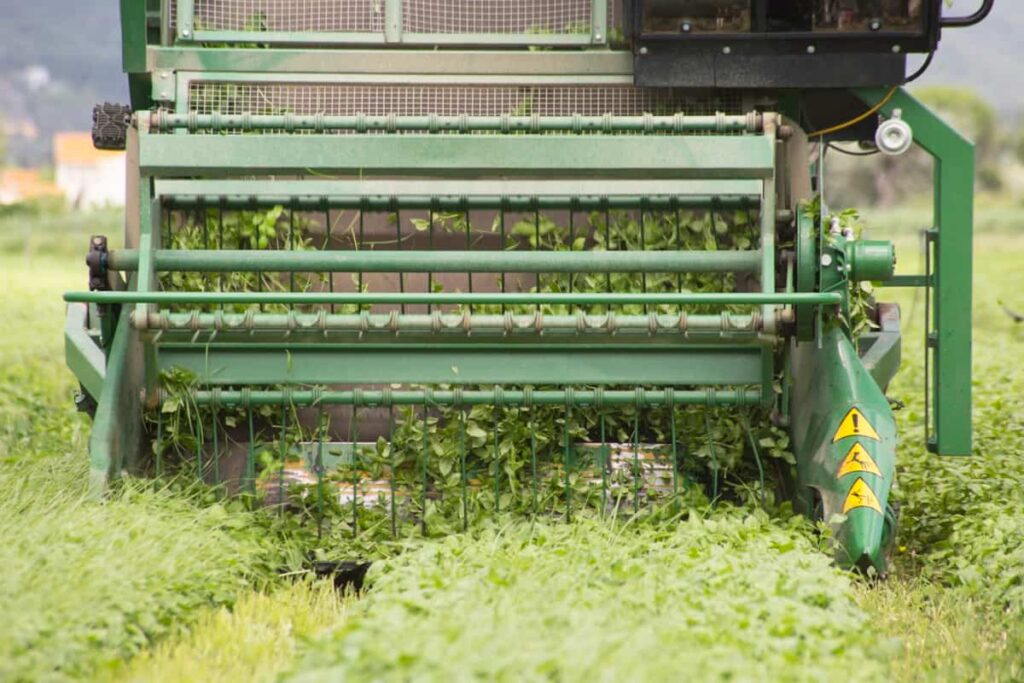
Post-harvesting management of Tulsi
- Handle produce well after harvesting
- Dry leaves or fresh leaves can be sold
- The steam distillation process for producing Basil or Tulsi Oil
- Transport and store in air-tight packaging.
Tulsi farming financial analysis: Investment, income, and profit for 1 acre of land
Tulsi Farming is a profitable agriculture business in India, as the demand for tulsi leaves and its products is increasing in the market. This report provides a financial analysis of the Investment, income, and profit for 1 acre of tulsi farming.
It includes the costs of seeds, labor, manure, pesticides, irrigation, bed preparation, weeding, harvesting, layout management, fertilizers, and miscellaneous expenses. It also includes the expected income and profit from selling Tulsi leaves and its products. This report will clarify the financial aspect of tulsi farming and help farmers make informed decisions.
Total Investment required for Tulsi farming business in India
| Particulars | Price (INR) |
| Cost of 1 kg of Tulsi seeds | 350 |
| Labor cost per day | 320 – 370 |
| Farmyard manure | 3,200 |
| Pesticides and fungicides | 2,500 |
| Transplanting labour cost | 3,000 |
| Nursery bed preparation | 2,000 |
| Weeding and hoeing | 3,200 |
| Harvesting cost | 2,000 – 2,500 |
| Layout management | 2,500 |
| Fertilizer cost | 2,500 – 3,500 |
| Application of fertilizers, Pesticides and Chemicals (Labour cost) | 1,200 |
| Miscellaneous cost | 3,000 |
| The total cost of Cultivation / Investment | 25,770 – 28,500 |
Revenue from Tulsi farming in India
On average, you can expect a yield of 5-6 quintals of dry Tulsi leaves per acre. The market price of Tulsi leaves ranges from INR 50-80 per kg. The price of tulsi products, such as tulsi oil and powder, can be significantly higher. Therefore, the total income from an acre of tulsi farming can range from INR 1.5-3.0 lakhs (assuming a yield of 5-6 quintals per acre and a price range of INR 50-80 per kg).
Profits from Tulsi farming in India
The net profit from 1 acre of Tulsi farming can be achieved by subtracting the Costs from the Income/Revenue. The profit from 1 acre of Tulsi farming is Rs 1.5-3.0 lakhs, and the costs of cultivating 1 acre of tulsi are around Rs. 28,000-30,000. Therefore, the net profit for 1 acre of Tulsi farming is Rs 1,20,000- 2,70,000.
Suppose the farmer follows proper care and management practices. However, these figures can vary depending on location, weather conditions, and market fluctuations. To Earn 1.5 lakh rupees per month, you need about 2.5 acres of land. On which you have to cultivate tulsi—the market price of tulsi leaves, its products, and the costs incurred in the farming process.
Based on an average yield of 5-6 quintals per acre and a market price of INR 50-80 per kg, 2.5 acres of tulsi farming can yield INR 1.5 lakhs per month. However, this is an estimate, and actual earnings may vary depending on location, weather conditions, pest and disease control, and market fluctuations. You also have to consider the operational costs for farming and handling the harvest and other costs related to the business, like labor, fertilizer, pesticides, etc.
In case you missed it: How to Get Rid of Fruit Fly in Cucurbits: Symptoms, Treatment, Chemical, and Organic Control
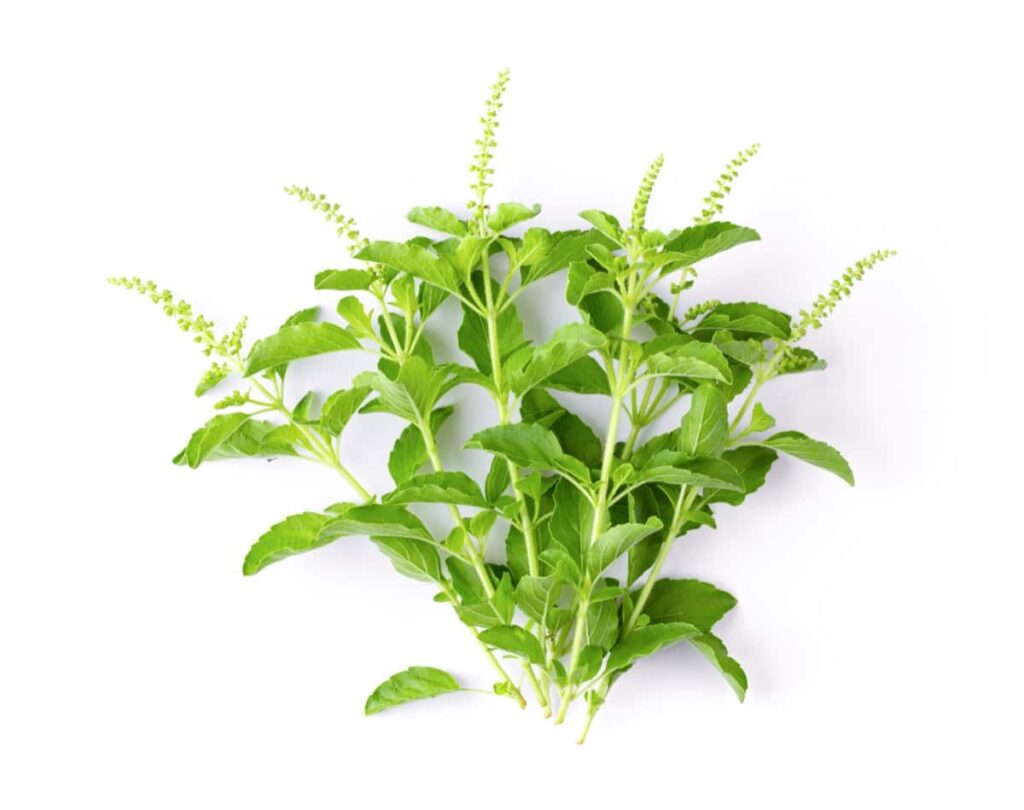
Is Tulsi farming profitable?
Tulsi farming is profitable as it can yield several times more profits than the initial investment in setting up and maintaining the tulsi plantation.
Which Tulsi is best for farming?
Rama Tulsi (Ocimum sanctum) is one of the most widely cultivated varieties of Tulsi for commercial farming. It is known for its high yields, good essential oil content, and tolerance to adverse weather conditions. Rama Tulsi is considered the best variety for farming because it has better tolerance to the winters and sunlight, which makes it well-suited for cultivation in different regions of India.
Are any loans or subsidies available for Tulsi cultivation?
Farmers who wish to start tulsi cultivation but need more capital can access loan facilities and government subsidies. The National Medicinal Plant Board (NMPB) provides subsidies for the growing and managing of medicinal crops, including a subsidy of 30% for tulsi under the National Ayush Mission (NAM).
Conclusion
Tulsi farming can be profitable for those willing to invest time and effort. Following the tips outlined in this post, such as selecting a suitable variety of Tulsi, properly caring for your plants, and finding the best markets for your products, you can earn up to 1.5 lakh rupees per month from tulsi farming. Remember that, like any business, success in tulsi farming also depends on location, weather, and market demand. With the right approach, however, tulsi farming can be a viable and rewarding source of income.
- Crops Grown in Summer Season: Best Choices for Summer Gardening
- Organic Pest Control for Tomato Farming
- How to Maximize Sheep Farming Profit
- Broccoli Varieties: Choosing the Right Cultivars for Your Farm
- How to Raise Pigs in Your Own Backyard: A Comprehensive Guide
- Budget Friendly Sheep Shed Ideas: Cheap and Low-Cost Tips
- How Much Do Cattle Farmers Make: Revenue Streams in Cattle Farming
- Management Pests and Diseases in Your Cotton Field
- Sheep Farming Business Plan for Beginners
- Aquaponic Farming at Home: A Step-By-Step Guide
- Profitable Village Farming Business Ideas in 2024
- High-Yield Aquaculture: Fast-Growing Fish for Farming
- Effective Fish Pond Construction Techniques for Beginners
- Irrigation and Water Management in Pineapple Farming
- Blossom to Harvest: Mastering Flowering and Pollination in Papaya Farming
- Pig Fattening Essentials: From Selection to Sale for Beginners
- Raising Wagyu Cattle: A Complete Guide for Premium Beef Production
- Soil Types and Their Water Holding Capacity
- Optimizing Irrigation Schedules for Coconut Groves for Enhanced Yield
- Espresso Your Garden: Coffee Grounds for Healthier Acid-Loving Plants
- The Best Soil Mix for Snake Plants: How to Mix Your Own Snake Plant Soil
- Green Thumb Success: Expert Tips for Cultivating Greenhouse Beans All Year Round
- Bloom All Year Round: The Ultimate Guide to Indoor Hyacinth Care
- Eco-Friendly Gardening: How to Make Liquid Fertilizer from Kitchen Waste
- Ultimate Guide to Grow Anise in Pots: Explore Seed Propagation to Harvesting
- Guide to Raising Chester White Pigs: Discover Breed Facts to Growth Management
- Mastering the Elegance: The Ultimate Guide to Weeping Cherry Tree Care, Planting, and Maintenance
- Ultimate Guide to Planting Garlic in Grow Bags: Growing Strategies for Beginners
- How to Fix Spider Plant Leaf-Related Problems: Natural and Organic Remedies
- 10 Reasons Why Your Tulsi Plant is Shedding Leaves: Home Remedies and Solutions
- Optimizing Growth and Yield: The Advantages of Palm Bunch Ash Fertilizer
- Utilizing Neem Oil Extract as a Natural Pesticide for Hydrangea
- From Soil to Harvest: Various Ways in Which Farmers Can Use AI Tools
- Steps to Encourage and Induce Citrus Flowers: A Comprehensive Guide
- How to Fix Snake Plant Leaf-Related Issues: Natural and Organic Remedies
- Transform Your Garden into a Fragrant Oasis with Raat Ki Rani (Night Blooming Jasmine)

How to sell tulsi leaves to direct company
Hi,
I kindly ask you how many kg we have to buy to have 36 000 seedlings/acre.
Where I can buy tulsi seeds in farming quantities.
Thank you
Luis